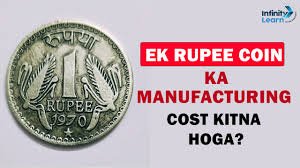The 1 rupee coin is one of India’s oldest and most frequently used currency units. While it is a small denomination, it plays an essential role in daily transactions and the broader economy. As we use these coins, we rarely think about the cost of producing them. A fascinating question often arises: Ek Rupee Coin Ka Manufacturing Cost Kitna Hoga? In this article, we’ll explore the cost involved in manufacturing the 1 rupee coin, the materials used, the minting process, and factors that influence the final cost.
Introduction: The Importance of the 1 Rupee Coin
The 1 rupee coin, first introduced by the British during colonial rule, has seen significant changes in design, material composition, and purpose. Today, it represents more than just a unit of currency; it’s an emblem of India’s independence and progress. However, as small as it is, the cost of producing a 1 rupee coin can sometimes exceed its face value. This article will break down how much it costs to manufacture the 1 rupee coin in India.
How Much Does It Cost To Mint One-Rupee
Materials Used in the Manufacturing of the 1 Rupee Coin
The composition of the 1 rupee coin has evolved over time, depending on factors such as cost, availability of materials, and technological advancements in coin manufacturing. As of now, the primary materials used in the production of the 1 rupee coin are nickel-brass for the outer layer and stainless steel for the core. Here’s a closer look at the materials used:
- Outer Layer: Nickel-brass alloy (75% copper, 20% zinc, and 5% nickel) gives the coin its golden hue and ensures it is resistant to corrosion.
- Inner Core: Stainless steel is used for its strength and durability. This composition ensures that the coin can withstand wear and tear over time.
Manufacturing Process of the 1 Rupee Coin
The process of manufacturing a 1 rupee coin involves several intricate steps. Each step adds to the total cost and complexity of production. Here’s a breakdown of the steps involved in minting the 1 rupee coin:
- Raw Material Procurement: The process begins with sourcing high-quality metals such as nickel, brass, and stainless steel. These metals are bought from suppliers and undergo processing.
- Melting and Casting: The raw metals are melted in furnaces and then cast into thin sheets. These sheets are subsequently stamped into coin blanks.
- Die Cutting: Coin blanks are pressed with dies to imprint the design. This includes the denomination and national symbols, like the Ashoka Pillar, the year of minting, and other intricate details.
- Edge Milling: To avoid wear and tear, the edges of the coins are milled to make them smoother and safer to handle.
- Quality Control: The coins are inspected for defects, ensuring uniformity in size, weight, and design. Any defective coins are discarded or melted down for reuse.
Breakdown of the Manufacturing Cost
Understanding the manufacturing cost involves considering the various expenses that go into producing a coin. Let’s look at the factors that influence the cost:
- Raw Material Cost: The prices of metals like nickel, brass, and stainless steel fluctuate with market conditions, directly impacting the production cost. Given that the coin is made of a metal alloy, fluctuations in raw material prices can raise or lower the overall manufacturing cost.
- Labor and Machinery Costs: Skilled labor is required for tasks such as die-cutting, quality checks, and packaging. Additionally, the large machinery needed for minting the coins requires energy and maintenance.
- Energy Cost: The production process, especially the melting of metals, consumes a considerable amount of energy, contributing to the cost of manufacturing.
- Transport and Distribution: Once the coins are produced, they are transported to banks and mints across the country, which adds to the overall cost.
- Packaging and Storage: The coins are carefully packed and stored before being distributed for use. These logistics costs are factored into the total cost of production.
Table: Specifications and Features of the 1 Rupee Coin
Below is a table that summarizes the key features and specifications of the 1 rupee coin:
| Specification | Details |
|---|---|
| Diameter | 25 mm |
| Thickness | 1.9 mm |
| Weight | 6.0 grams |
| Material Composition | Nickel-brass (outer layer), Stainless steel (inner core) |
| Color | Golden color (due to nickel-brass) |
| Design | Ashoka Pillar on one side, Value (₹1) on the other |
| Minting | The coin is minted at various government mints across India |
| Durability | Highly durable, resistant to wear and corrosion |
| Year of Minting | Year is mentioned on the coin, typically updated every year |
| Edge Type | Smooth, no distinct ridges |
Estimation of the 1 Rupee Coin’s Manufacturing Cost
Now, let’s address the main question: ek rupee coin ka manufacturing cost kitna hoga?
On average, the cost of manufacturing a single 1 rupee coin in India is approximately ₹1.50 to ₹2.50. This cost fluctuates based on:
- Changes in raw material prices: As commodity prices like nickel and brass rise or fall, the cost of the coin will adjust accordingly.
- Economic conditions: Inflation, labor costs, and energy expenses all play a role in the final cost.
- Volume of production: Larger batches of coins can reduce the per-coin manufacturing cost due to economies of scale.
It’s interesting to note that despite the production cost being higher than the face value, the 1 rupee coin continues to be an essential currency in the economy due to its longevity and widespread use.
The Role of Technology and Innovation in Modern Society
Why the Manufacturing Cost Exceeds the Coin’s Face Value
You might wonder why the cost to produce a 1 rupee coin is more than its actual value. This phenomenon is common in many countries for low-denomination coins. Here’s why:
- Material and Production Costs: The raw materials, labor, energy, and machinery required to produce these coins add up. Governments usually absorb the extra costs because of the need for low-denomination currency.
- Longevity of Coins: Coins have a much longer shelf life compared to paper currency. Over time, their durability outweighs the higher initial manufacturing cost.
- Government Subsidy: Governments typically subsidize the production of coins to ensure that small transactions can take place efficiently in the economy.
- Inflation: The cost of producing coins increases with inflation, while their face value remains fixed. This disparity continues to grow over time, but it doesn’t affect the circulation of the coins.
Conclusion
In conclusion, the manufacturing cost of a 1 rupee coin in India is significantly higher than its face value. On average, the cost ranges from ₹1.50 to ₹2.50 per coin. This cost involves several components such as raw materials, labor, energy, and distribution. Despite the manufacturing cost exceeding the coin’s face value, the 1 rupee coin remains a vital part of India’s economy, ensuring efficient transactions for small purchases.
The government continues to produce these coins, subsidizing their manufacturing costs, as they provide essential utility, especially for rural and lower-income populations. Although the cost may seem disproportionate, the coin’s long lifespan, low cost per transaction, and widespread use make it a critical currency in India.



